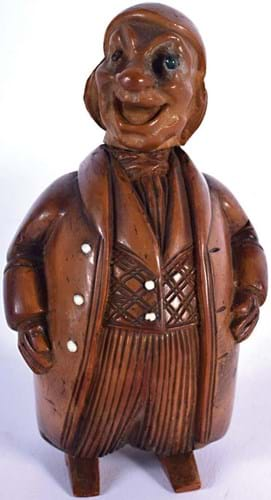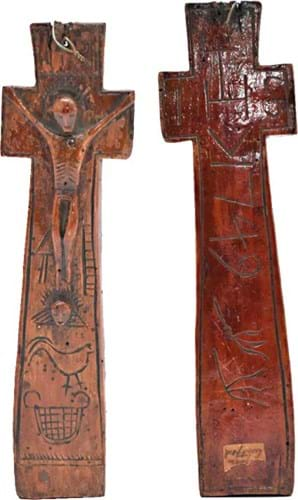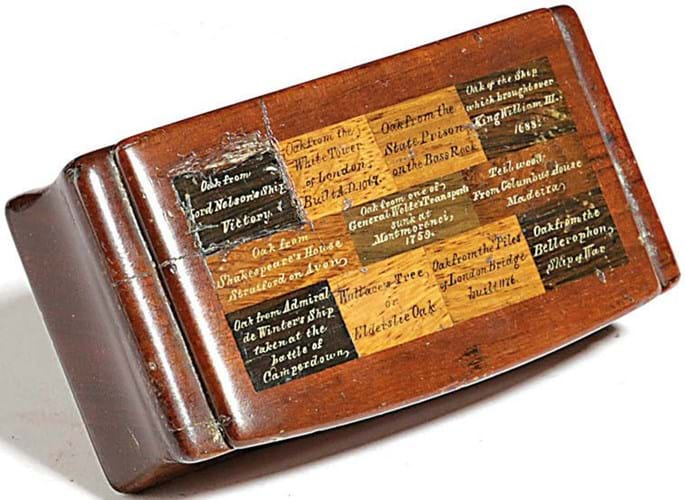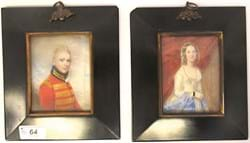By the early 19th century the coquilla nut had been ‘discovered’ by British craftsmen as a suitable medium for carving.
The influential taste-making journal Ackermann’s Repository of Arts, Literature, Commerce, Manufactures, Fashions, and Politics sung its praises in 1812.
“The uncommonly pleasing colour of the shell, the hardness and the native mottle which appears when it is highly polished, renders it capable of being employed, with the most agreeable effect, as it is susceptible of the most tasteful forms,” the journal stated.
“Whatever has been formed from ivory, may be produced from the shell of the coquilla, whose beauty will not fail to attract, while the price of the article will satisfy the purchaser.”
The signature coquilla carved trinket was the snuff box, and particularly the comical ‘nut men’ made across northern Europe in the first half of the 19th century.
Most depict caricatured European ‘types’. Typically, these are sold for £300-500 but the best examples, often with details picked out in bone, can bring significantly more.
A box of a rotund gentleman with a beaming jocular face took a 10-times top estimate £1500 at Hannam’s (23% buyer’s premium) in Selborne on January 4, selling to a buyer via thesaleroom.com.
A small collection of similar boxes comes for sale at Bishop & Miller in Stowmarket on January 27.
Cross purpose
A particularly good example of Irish treen surfaced at Halls (20/12% buyer’s premium) of Shrewsbury on December 8.
An 18th century Irish fruitwood ‘penal cross’ made nearly treble its low estimate to sell for £2800.
Standing 8½in (22cm), it is carved with the figure of Christ crucified in high relief, flanked by an incised ladder and spear, with ‘cock over pot’ symbols depicting the Passion. Bursting with naive charm, the fact that it was dated verso (1749) added to its appeal greatly.
While it is thought these crosses were made to sell to pilgrims visiting the pilgrimage site at Lough Derg, they also represented a challenge to the Penal Laws that were in full force at the time.
Royal box
Another treen item with significant crossover collecting interest was a small 4in (10cm) specimen wood snuff box offered by Woolley & Wallis (25% buyer’s premium) as part of the Salisbury firm’s Furniture, Works of Art & Clocks sale on January 12.
Stamped C Stiven & Sons, Box Makers to Her Majesty, Laurencekirk for the ‘Mauchline’ ware maker Charles Stiven, it is inlaid with 22 different titled wood samples including Oak from Lord Nelson’s Ship Victory, Oak from the State Prison on Bass Rock and Oak from the Florida Ship of the Spanish Armada, destroyed at Mull 1588.
Part of the sale titled A Lifetime of Collecting – The Property of a Gentleman, it was estimated at £150-250, but took £1300 on thesaleroom.com.
From the same source was a nicely carved late 19th century fruitwood snuff box in the form of a toad with mother of pearl eyes. Animal boxes such as this are always popular, this one bringing £2000 (guide £300-400).
High demand
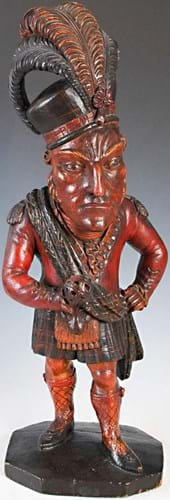
Late 18th or early 19th century carved and painted wood ‘cigar store’ figure – £6800 at Lindsay Burns.
Among the most desirable of all Georgian and Victorian carved wood objects are ‘cigar store’ figures– the large (sometimes life-size) polychrome models designed to encourage the tobacco-buying customer.
The two Highlander models offered by Lindsay Burns (20% buyer’s premium) as part of the four-day sale in Perth on December 7-10 came with a provenance to the Rattray collection the rooms had sold in April 2017. Charles Rattray was a tobacconist and blender of fine tobaccos at 160 High Street, Perth, between c.1915 and 1981. Former Prime Minister Harold Wilson was one of the famous names on a long list of customers.
The 2ft (60cm) high counter-top figure of a Highlander, c.1800, modelled with feather-plumed cap and holding a basket-hilted sword in his right hand, had long been on display there. It can be seen in situ on the mantelpiece in ‘The Sales Salon’ in an early 20th century sepia photograph.
Five years ago, when estimated at £600-800 it had sold at £7800. This time around, guided at £5000-7000, it took £6800.
Sold at £4800 (estimate £4000-6000) was a Victorian figure of a bearded Highlander taking snuff from his mull. It was larger, measuring 4ft (6in (1.34m) high, but had been repainted several times.
Decorative appeal
Carved wood lay figures also make for terrific decorative objects – guaranteed to enliven a range of interior spaces far removed from the artist’s studio. The best examples command very significant sums.
The figure pictured above measures 3ft 4in (1m) high, is fully articulated, particularly well carved and exhibits a good colour and patination. It came for sale at Greenslade Taylor Hunt (19.5% buyer’s premium) in Taunton on January 6 from a family home where it had been for many years. The imperfections to the toes were blamed on a hungry family pet.
Guided at £300-500, it took £7000 via thesaleroom.com.


